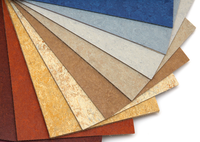








Linoleum is a floor covering made from materials such as solidified linseed oil (linoxyn), pine rosin, ground cork dust, wood flour, and mineral fillers such as calcium carbonate, most commonly on a burlap or canvas backing; pigments are often added to the materials.
In 1860, rubber manufacturer Fredrick Walton invented linoleum, the floor and wall covering often used in Victorian homes. Three years later, Walton received a British patent for his invention. Fredrick Walton was inspired to invent linoleum as a cheap substitute for the more expensive rubber composition called Kamptulicon. Walton got the idea for his product by observing the skin produced by oxidized linseed oil that forms on paint.
Together with inventor Fredrick Thomas Palmer, Fredrick Walton went on to invent Anaglypta and Lincrusta. Anaglypta and Lincrusta are two forms of Victorian-era embossed home wall coverings. Lincrusta is made of a linseed oil mixture and Anaglypta is made from cotton pulp.Linoleum was made famous by Scottish flooring manufacturer Michael Nairn, who introduced the inlaid patterning that linoleum is best known for.Linoleum was later replaced in popularity by the vinyl floor coverings of the 1960s. However, it is now making a comeback.
Origin
The name linoleum comes from the Latin word linum, which means flax, and the Latin word oleum, which means oil.
How it is made
Linoleum is made of linseed oil, pigments, pine rosin and pine flour. Linoleum is manufactured by oxidizing linseed oil and adding the other ingredients to form a thick mixture called linoleum cement. According to the Columbia University Press, "linseed oil is exposed to the air in a succession of thin films until it is of a rubbery consistency, or it is thickened by heating until it becomes a spongy mass, after which it is ground, mixed with pulverized wood and other ingredients, and then applied to the foundation and rolled smooth.The final process is a thorough seasoning in drying rooms."